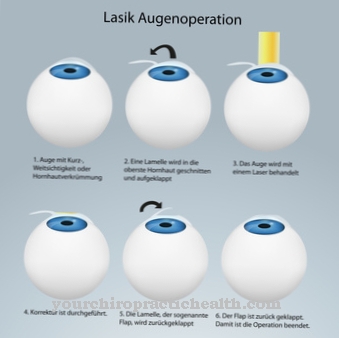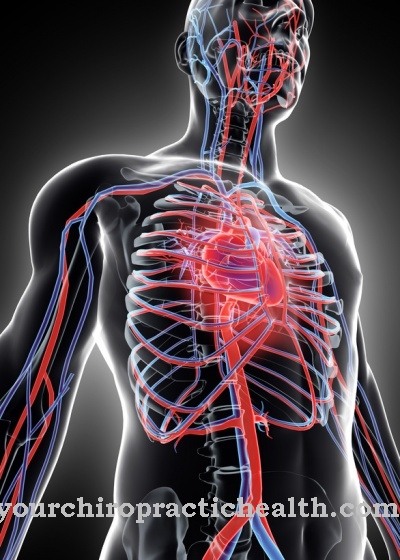The lungs are a vital organ that is responsible for gas exchange in the body. However, certain diseases and complaints can impair the function so irreparably that a transplant with a donor organ becomes necessary. A Lung transplant holds numerous opportunities and advantages, but also risks that should not be ignored.
What is the lung transplant?

The lungs are a complex organ. It can be differentiated into the left and right lung. Depending on the type of discomfort and the degree of damage, one wing, both wings or individual lobes are replaced in a transplant.
The aim is to replace the no longer functional tissue with a healthy organ so that the vital processes can continue and the patient's life can be saved. Before a lung transplant can be used, however, the disease must be well advanced and no longer treatable with medication and other therapies. On the one hand, the proportion of donor organs is scarce; on the other hand, the risks of a lung transplant predominate in less severe cases.
The basis is a detectable shortness of breath in the patient and a life expectancy that is less than 18 months without a donor organ. The damage to the tissue is caused by various diseases. These include, for example, idiopathic pulmonary fibrosis, chronic obstructive pulmonary disease or pulmonary hypertension. However, a lung transplant is considered a last resort for any illness.
Function, effect & goals
Before the transplant can take place, many patients have already gone through a long path of suffering, which mainly consists of the waiting list. Who receives one of the limited donor lungs and who does not depend on numerous factors and tests. These include, for example, the age of the patient and the general state of health. If the transplant has been approved, the first step is preparation time before the operation.
The aim of this phase is to make the individual risk of the person concerned as small as possible. For this purpose, the thorax area is examined using X-rays and a CT. Lung function tests and heart examinations are carried out. In order to rule out the presence of tumors and infections, a laboratory test of the blood is also carried out. The preparation time is concluded with a psychological report; a transplant represents an emotional burden. Based on the documents, it is finally decided within which period the operation should take place. If a suitable donor organ has been found, the procedure is initiated immediately.
In most cases, both lungs are transplanted. Surgery on just one can cause a serious infection. To remove the tissue, an incision is first made in the thorax. The diseased part can be removed through the opening and the healthy organ inserted. The doctors first connect the lung bronchi and pulmonary veins, then the pulmonary arteries. When the blood is able to circulate again, the new lungs begin to function. If the transplant has been successfully completed, the tissue is sutured.
After completing the operation, the patient must first stay in the intensive care unit. As a rule, the aim is to move to another ward within a week. However, complications occur in around 15 percent of all lung transplants that require a longer stay in the intensive care unit. The transplant is accompanied by a 3-week hospital stay with rehabilitation measures. Patients have to take drugs that prevent the body from rejecting the new lungs.
The aim of the operation is to allow the disturbed gas exchange to proceed properly again. If the procedure has been successfully completed, the body will be able to optimally supply the cells with oxygen and at the same time excrete the waste products.
Risks, side effects & dangers
As with any operation, there are health risks associated with a lung transplant. These are already caused by the anesthetic. Symptoms such as thrombosis or infections cannot be ruled out. Unclean seams can lead to leaks and bleeding into the tissue.
Studies have also shown that around 30 percent of all patients experience an acute rejection process in their body with their new lungs at least once in the course of their lives. This leads to inflammation because the organism does not recognize the new tissue as the body's own cells. Instead, it produces antibodies to destroy the supposed foreign body. These attack the lungs and inflammation develops. Patients notice the reaction through fever, dry mouth, impaired function of the organ, tiredness and shortness of breath.
Treatment with antibiotics and immunosuppressants can often eliminate the phenomenon. In the first year after the operation in particular, patients also increasingly complain of infections with viruses, fungi and bacteria. Decisive for the frequent occurrence is the weakened immune system. In this way, pathogens can easily penetrate the body and cause diseases there.
A lung transplant can cause respiratory complications. These are often based on narrowed airways, which in turn are based on the seams. However, medical procedures now exist that have reduced the occurrence of such complaints. These include, for example, stents, which the body breaks down after a while, or small balloons. Regular check-ups are essential so that the numerous possible risks can be identified at an early stage. In these, blood is drawn from the patient, the function of the lungs is tested and the external appearance of the bronchi is examined.













.jpg)

.jpg)
.jpg)











.jpg)